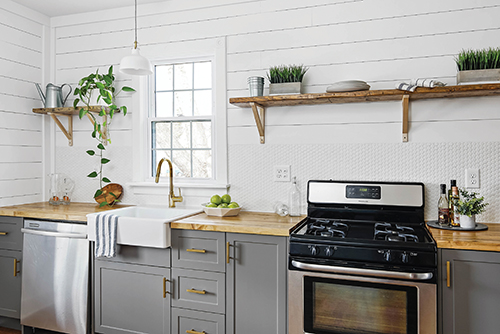Loggerhead sea turtles eat their weight in jellyfish each day. When you weigh 400 pounds or more, that’s a lot of jellyfish. Unfortunately, when the turtles swim through swarms of jellyfish, vacuuming them down, they eat quite a few plastic bags in the process. When that happens, over time the sea turtle’s digestive system becomes clogged with plastic and, not surprisingly, the turtle dies.
That’s sad, but what does it have to do with your next rehab? More than you might think.
Fix-and-flippers and their eventual buyers are discovering that using sustainable materials, products that provide environmental and economic benefits, on a rehabbed property does not only make the buyer feel good about saving the planet; it also can substantially increase overall returns. However, using “sustainable materials” is definitely an art. If you are not careful, you could end up just as far over budget as if you took your remodeling cues solely from reality real estate television and installed the finest marble counters and latest sculptured fixtures in every rental. For the environmentally conscious real estate investor and their retail buyers, practical decisions should outweigh emotional ones on the topic of sustainable materials just as they should in other investment decisions.
“Key financial benefits of green construction generally relate to lower operational costs, lower energy, waste, and water costs, lower maintenance costs, and increased productivity and health,” observed Sumateja Reddy, a professionally accredited architecture expert with the Indian Green Building Council (IGBC) in India. Reddy’s research indicates that green building and green renovations are most effective when treated less as a trend and more as a benefit to the residents of the structure. This makes renovation using sustainable materials much more of a science than an art because an investor may leverage measurable goals and metrics when deciding when and where to use sustainable materials.
“The basic goal of green building is attractive, comfortable, and affordable shelter that does no harm to the earth,” Reddy added. Ultimately, the structure should “create a more desirable human experience.”
The Costs & Benefits of Sustainable Options
Probably one of the easiest sustainable moves you can make in any property, whether you plan to rent it out or flip it to a retail buyer, is to incorporate LED lighting options into the home. While a typical LED light will only save about five dollars each year in energy costs (probably about $100 a year cumulatively if you replace most or all bulbs in the home) compared to an incandescent bulb, over time they will also save you (or the new owner) a great deal of money on replacement bulbs. Furthermore, LED lighting is one aspect of a home that homeowners or residents can happily point to as evidence that they care about the earth, which makes the investment a good one when it comes to appealing to a potential buyer’s emotional side.
One important thing to note about LED lighting: while you can “plug and play” an LED light into just about any fixture, installing LED fixtures will optimize the life of LED lighting and make it more user-friendly. Particularly if you are putting LED lights into fixtures with dimmers, consider replacing the entire dimmer feature with one designed for LED bulbs. Depending on the area of the country in which you are building, installing LED-specific fixtures may help you meet strict building codes or qualify for tax advantages on the home. It will also improve the quality of the light, which is a common complaint about LED options.
Using sustainable lighting options is great, but there are a lot more ways to incorporate sustainable materials into your rehab. Windows are a highly attractive staple of sustainable buildings because they add value to the home through energy savings while simultaneously improving curb appeal. Depending on the nature of the comps in your area, you may want to opt for double- or triple-pane windows, gas-filled panes, and a variety of modern frame designs. Take time to investigate comps in the area to identify what options buyers appear to expect, then evaluate in light of your rehab budget. Remember, cutting corners on an “option” like windows can hurt you in the long run if every other property for sale in the area has better windows and better energy savings than yours does.
 Recycling, Repurposing & Upcycling
Recycling, Repurposing & Upcycling
When you think about using sustainable materials in a rehab, you probably did not first leap to lighting and windows. After all, those are not necessarily “fun” aspects of sustainable design. The good news for investors with an eye for upcycling, recycling, and repurposing is that buyers feel the same way you do in many cases! They want to see the visual appeal of their sustainable decisions, which leads to some great opportunities for really enjoyable, creative interior design decisions.
Of course, this is also the area most “dangerous” to your budget. Sure, repurposed barn doors are great, and a historic neighborhood certainly lends itself to your use of the old cellar wood as newly refinished hardwood floors. Correctly done, you can turn that old butcher’s block you found in a field into an absolutely breathtaking kitchen island. “Correctly done” is the key. Consider three factors when considering these types of design decisions:
- Time
- Cost
- Resident appeal
The cold, hard facts for real estate investors demand you temper your desire to use recycled, repurposed, and upcycled materials with your bottom line. Any time the two do not appear to mesh in a beneficial way, think very hard before continuing down that route to using sustainable materials. You can’t help the sea turtles — much less yourself and your real estate investing business — if you go broke in the process.


 Recycling, Repurposing & Upcycling
Recycling, Repurposing & Upcycling





















0 Comments